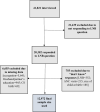Maternal and child factors associated with late neonatal bathing practices in Nigeria: evidence from a national survey
- PMID: 37658372
- PMCID: PMC10474679
- DOI: 10.1186/s12978-023-01676-y
Maternal and child factors associated with late neonatal bathing practices in Nigeria: evidence from a national survey
Abstract
Background: Twohundred and seventy out of every thousand live births died in Nigeria in 2019. These deaths were attributable to infections, complications of preterm birth, and intrapartum-related conditions. The World Health Organization recommends withholding bathing of neonates until 24 h after birth or until their vital signs become stable to prevent hypothermia. Despite the link between neonatal bathing and thermal control, the subject is understudied in Nigeria. This study aimed at investigating the factors associated with late neonatal bathing practices in Nigeria.
Methods: The study adopted a cross-sectional design and extracted data from the women's file of the 2018 Nigerian Demographic and Health Survey. The unit of analysis was limited to 12,972 women who had complete data for the study. We applied chi-square test of independence to ascertain the association between the outcome variable and explanatory variables. At 95% confidence interval, two logistic regression models were built with Model I consisting of only maternal factors whilst Model II contained both maternal and child factors, and results were presented in adjusted odds ratio.
Results: Descriptively, 12% (CI = 0.122-0.134) of the women bathed their neonates after 24 h of delivery. Inferentially, women with secondary/higher education [AOR = 1.30, CI = 1.05-1.61], the rich [AOR = 1.24, CI = 1.03-1.50], those with access to mass media [AOR = 131, CI = 1.15-1.50], women that professed other religions [AOR = 9.28, CI = 4.24-17.56], those who delivered in a health facility [AOR = 1.93, CI = 1.66-2.25], whose child was small in size at birth [AOR = 1.46, CI = 1.21-1.77] and delivered by caesarean section [AOR = 2.50, CI = 1.97-3.18] had higher odds of bathing their neonates 24 h after birth.
Conclusions: The proportion of women who practised late neonatal bathing was generally low. To improve the practice of late neonatal bathing, much-concerted effort should be directed to women's education and approaches to increasing receptivity of late neonatal bathing among pregnant women through the media. The Nigerian Ministry of Health should incorporate routine counselling on the risks of bathing newborns prematurely into antenatal and postnatal care services.
Keywords: Late neonatal bathing; Maternal and child factors; Neonatal health; Nigerian Demographic and Health Survey; Reproductive health.
© 2023. BioMed Central Ltd., part of Springer Nature.
Conflict of interest statement
The authors declare that they have no competing interests.
Similar articles
-
Coverage-level and predictors of maternity continuum of care in Nigeria: implications for maternal, newborn and child health programming.BMC Pregnancy Childbirth. 2023 Jan 18;23(1):36. doi: 10.1186/s12884-023-05372-4. BMC Pregnancy Childbirth. 2023. PMID: 36653764 Free PMC article.
-
Maternal and child factors associated with early initiation of breastfeeding in Chad: evidence from nationally representative cross-sectional data.Int Health. 2022 Sep 7;14(5):510-518. doi: 10.1093/inthealth/ihab060. Int Health. 2022. PMID: 34614156 Free PMC article.
-
Individual and community-level factors associated with early initiation of antenatal care: Multilevel modelling of 2018 Cameroon Demographic and Health Survey.PLoS One. 2022 Apr 6;17(4):e0266594. doi: 10.1371/journal.pone.0266594. eCollection 2022. PLoS One. 2022. PMID: 35385559 Free PMC article.
-
Women's knowledge towards neonatal danger signs and its associated factors in Ethiopia: a systematic review and meta-analysis.BMC Pediatr. 2020 May 14;20(1):217. doi: 10.1186/s12887-020-02098-6. BMC Pediatr. 2020. PMID: 32408874 Free PMC article.
-
Trends in neonatal mortality in Nigeria and effects of bio-demographic and maternal characteristics.BMC Pediatr. 2015 Apr 9;15:36. doi: 10.1186/s12887-015-0349-0. BMC Pediatr. 2015. PMID: 25886566 Free PMC article. Review.
Cited by
-
Early newborn bathing practice and its determinants among postpartum women in Ethiopia: a systematic review and meta-analysis.BMC Pregnancy Childbirth. 2024 Jan 27;24(1):87. doi: 10.1186/s12884-024-06280-x. BMC Pregnancy Childbirth. 2024. PMID: 38281013 Free PMC article.
References
-
- United Nations Inter-agency Group for Child Mortality Estimation (UN IGME). Levels & trends in child mortality: report 2020, estimates developed by the United Nations Inter-agency Group for Child Mortality Estimation. United Nations Children’s Fund, New York; 2020.
-
- World Health Organization. Sustainable development goal 3: health. 2021. https://www.who.int/topics/sustainable-development-goals/targets/en/. Accessed 25 Mar 2021.
MeSH terms
LinkOut - more resources
Full Text Sources
Medical


